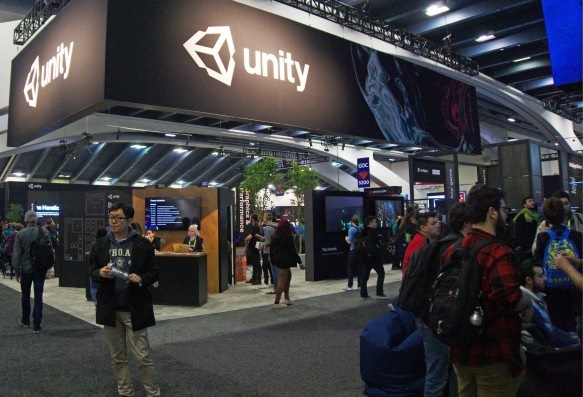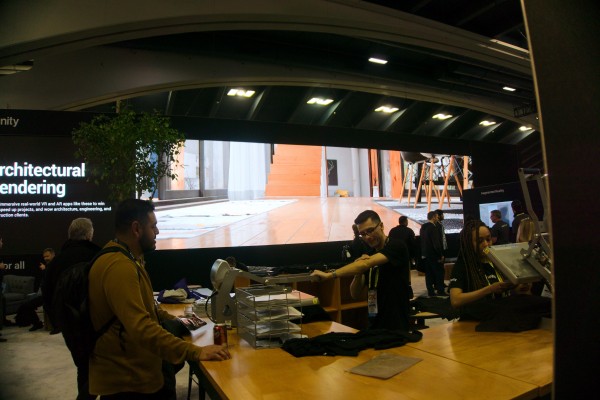Keep up and stepping out

Unity came to GDC fighting the perception it’s riding back seat to Epic’s position in the shotgun seat. The company made some progress during this year’s over 2-hour long keynote—not that Unity ever admits for a moment it’s chasing Unreal and, in fact, there’s much to argue that Unity has built a good position on its own turf, which has been in mobile and with indies. However, in his keynote, CEO John Riccitiello took a shot or two at the competition. “We’re not here to make games,” he said to underline that Unity does not compete with customers. And, he went on to praise the indie game developers who represent the core of Unity’s development community in numbers if not in revenue.
Most important, Riccitiello used his keynote time to position Unity for the future. Not content to be a leading resource for developers on mobile platforms, Riccitiello stressed that Unity is a development tool for PCs, consoles, online, with support for over 25 platforms and also for future platforms. Unity is onboard with Google’s Stadia, and they’re also teaming with Tencent, which, he said, gives Unity developers a pathway to the huge market for gamers in China.
Riccitiello talked about the ways in which Unity’s mission has evolved from its origins as pure game development tool saying the company now offers tools to create, operate, and monetize content.
Create
A lot of the new technical advances Unity had to sell for its latest rev. Unity 19.1 are wrapped up in the company’s The Heretic, which features Unity’s digital human technology, and new rendering techniques including real-time ray tracing.

For The Heretic, the Unreal demo team made 3D and 4D scans to create the character and put all their tricks to work in rendering using the SRP (scriptable rendering pipeline), and the HDRP (high definition rendering pipeline) for post-processing optimizations. Part of the point of The Heretic was the demo’s use of naturalistic lighting. The lighting is good, but it’s also pretty hard to resist pointing out it’s dark giving the artists and rendering tools cover for shortcuts.
Unity wasn’t about to step back and conceded the ray tracing field to Unreal. The company showed off its real-time ray tracing accelerated through RTX, but The Heretic is designed to demonstrate the quality of content that can be created with Unity within the bounds of normal game development. And that was a bit of Unity’s underlying message. The company is optimizing its tools for the coming era of streaming content and also to highlight its legacy of mobile gaming development as mobile gaming becomes increasingly popular.
Light Weight Render Pipeline
Unity is releasing the LWRP, which they introduced last year, in the 2019.1 release. The company says it has reworked shaders, batching, and rendering to enable rendering that goes easy on bandwidth demand. Real-time ray tracing is on the runway, but Unity developers working on games for the near term still need ways to create games that can run well on any platform but have a high-end look.

Real-time rendering
Unity did show off real-time ray tracing, which is Nvidia’s signature feature for RTX. It debuted at Nvidia’s GTC as well as at GDC and the focus was primarily on non-gaming applications for Unity’s technology. That includes creating demos, configurators for products (build your own car with available options), AEC walkthroughs, and previz for content creation. Unity promises the real-time ray tracing tools will be available later in 2019.
DOTS
Unity has developed the Data-Oriented Technology Stack (DOTS) to provide a more accessible development tool that efficiently translates to machine code for high performance. DOTS is based on a subset of C#, Unity is calling HPC# (High-Performance C#) that has been optimized for the Unity engine and also for multicore processors. Key to the efficiency of DOTS is Unity’s Burst Code Generator/Compiler that has been shipping with Unity 2018.3. Unity’s Lucas Meijer has written a helpful blog on the subject, and you’re better off reading that than my interpretation.
DOTS represents a significant reworking of Unity’s core foundation and the company expects DOTS to enable developers to develop a wide range of new games from Mobile to Triple-A.
At GDC 2019, Unity announced a partnership with Havok to develop Unity Physics, which will be available in DOTS.
Game Foundation
Unity is introducing tools to help game developers with common tasks such as inventory, currency management, virtual stores, and player progress.
AR Foundation
The AR Foundation Framework simplifies the development of AR content which can be deployed across ARKit and ARCore.
Operate
Unity’s services to enable game developers to better operate their game include the newly acquired Vivox, and also the Multiplay game server, and Adaptive Performance.
Vivox provides voice and chats for games including Unreal’s Fortnite, and also PUBG (Player’s Unknown Battlegrounds) from Infinity Games, and League of Legends from Riot Games. At GDC, Unity announced that the Vivox SDK will be available for all game engines and developers can integrate the Vivox service in their Unreal games in a few weeks.
Multiplay: Unity is deprecating its older Multiplayer (UNet) system APIs and in favor of Multiplay, a leading game server that powers PUBG, Apex Legends Titanfall, and Rocket League. Rocket League gathered 50 million players in its first month. Multiplay offers customized game server hosting for any engine and platform. It supports hybrid cloud hosting and managed infrastructure services. The company’s tools also include matchmaking. They have partnered with AWS and Google.
Adaptive Performance is an ongoing investment from Unity for mobile game developers which gives developers data about their game’s thermal load on devices and whether games are CPU- or GPU-bound at runtime, enabling developers to adapt games dynamically and proactively. At GDC, Unity announced support for Adaptive Performance from Samsung for the Galaxy S10 and the Galaxy Fold. Support for more devices is promised in the future.
Monetize
A lot of Unity’s developers are hobbyists. However, quite a few of them would like to help to make money for their efforts as well.
Unity Ads is a resource that enables game developers to incorporate ads in the games as shamelessly or as lightly as they might want. Unity offers Unified Auctions which ensure the game developer gets the best deal for its ad space.
At GDC, Unity announced the open beta launch of the Unity Distribution Portal (UDP), which will give developers a resource for distributing their games through apps stores in emerging markets. UDP creates builds for different stores. The first stores being enabled are Catapult (Aptoide) and Moo Stores. ONE Store and Jio GamesStore are coming soon.
It’s game on for Unity, which spent quite a bit of its keynote time promoting its abilities for high-end games as well as streaming and, of course, mobile.
What do we think?
Unreal and Unity hit a lot of the same marks on the GDC keynote stages. Both companies offered services available to games developed on any game engine. Unreal has a very big tent right now with its huge Fortnite gamer base and it’s Online Services SDK, which helps developers adds cross-platform support for gameplay, friends, etc. But, Unity obviously hopes to jump-start its streaming game with a partnership with Multiplay and support for Google’s Stadia.
Both companies have proved there are millions and millions and millions of dedicated games players so there’s plenty of room for both teams to play, but don’t count on anyone playing nice.
One aspect we didn’t address, yet, is the opportunity for game engines in new markets, which we see developing more slowly, but have interesting application throughout the digital world.





